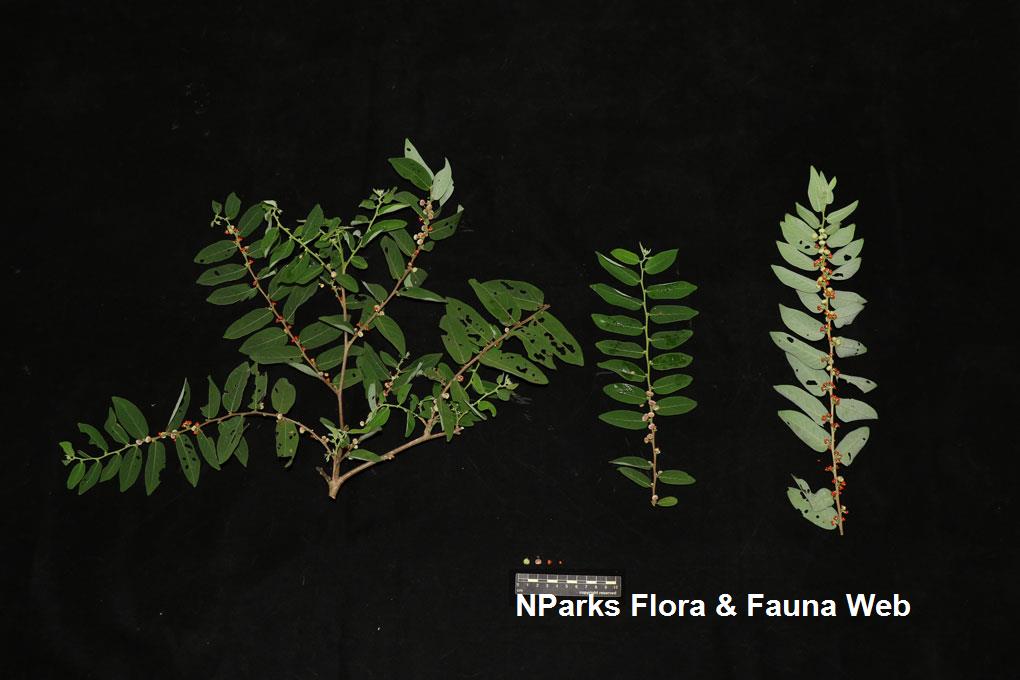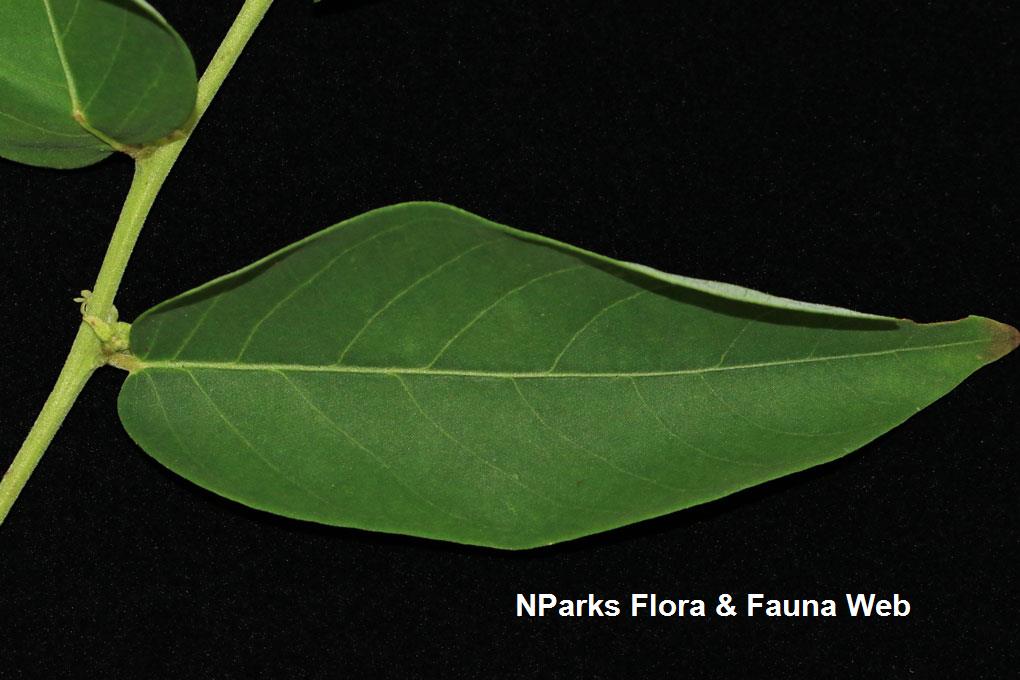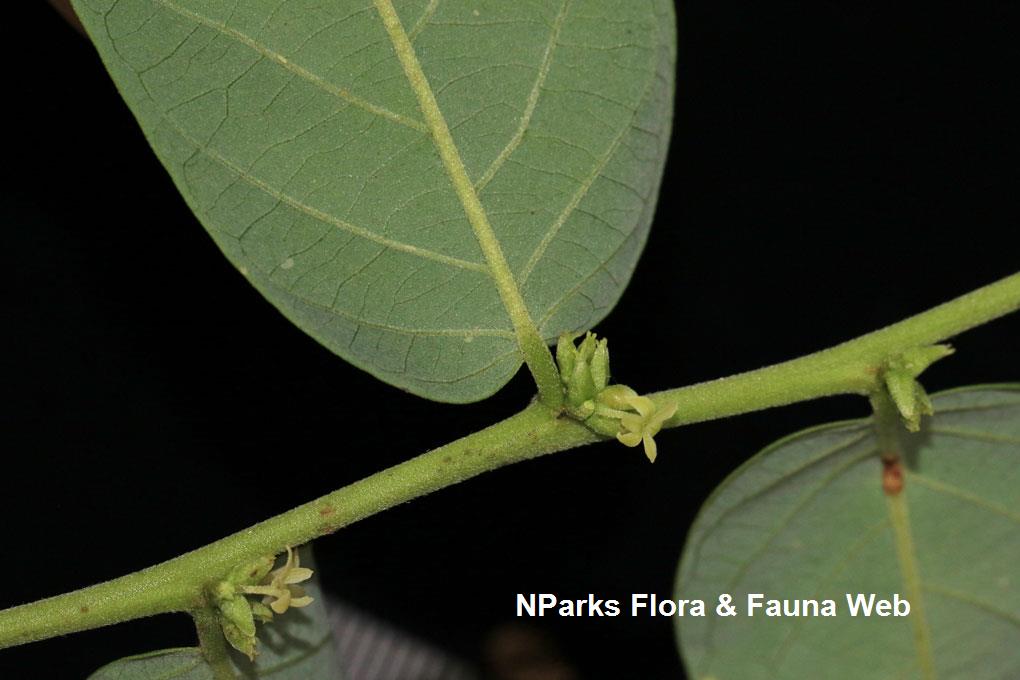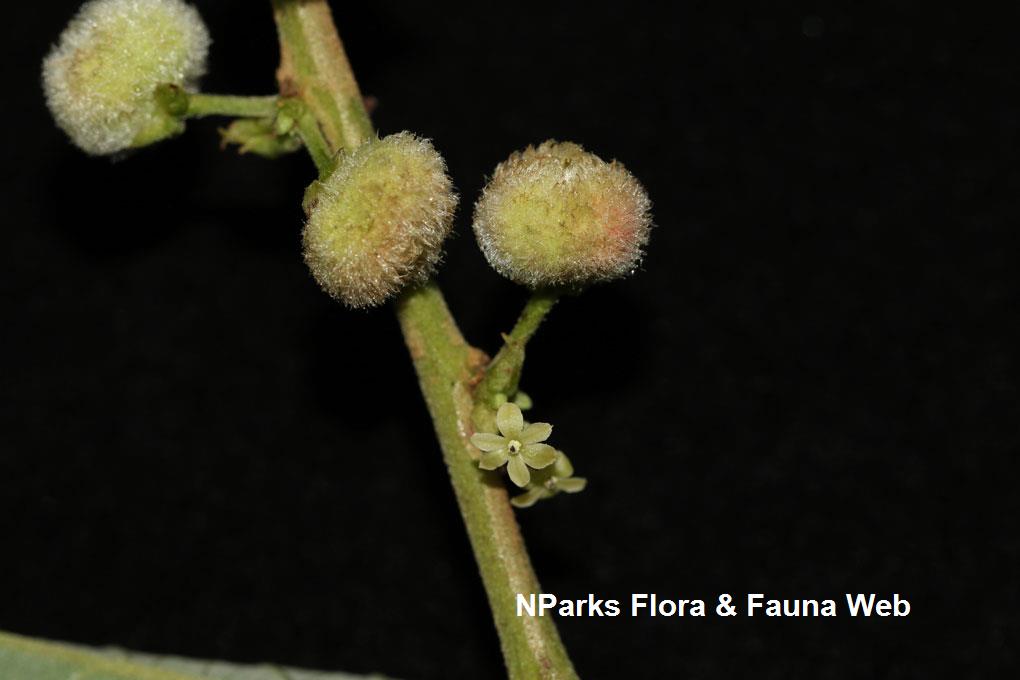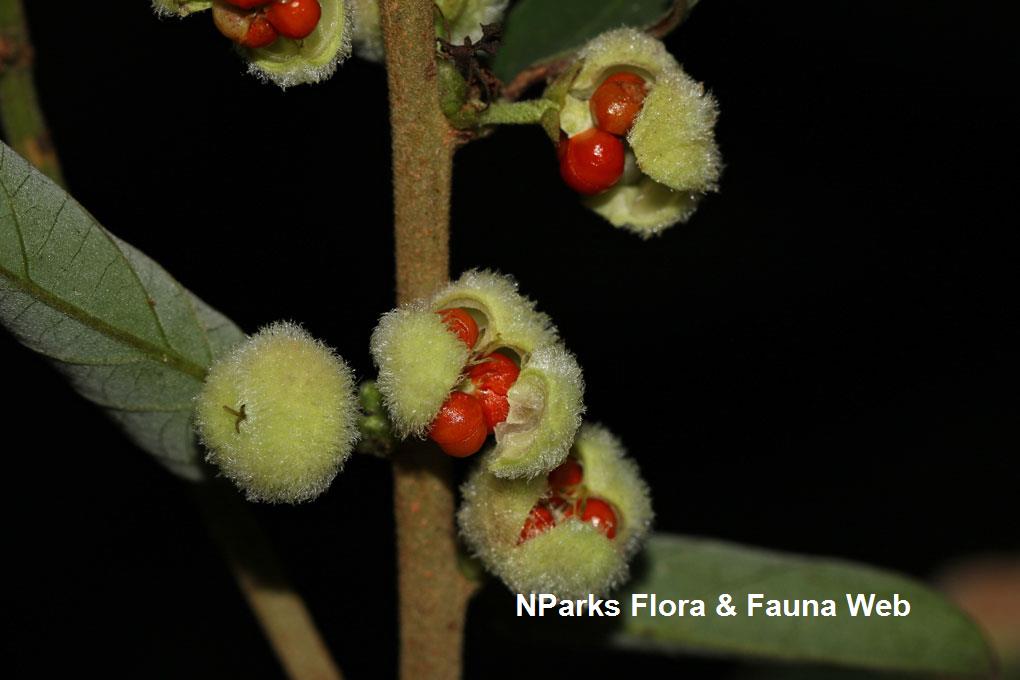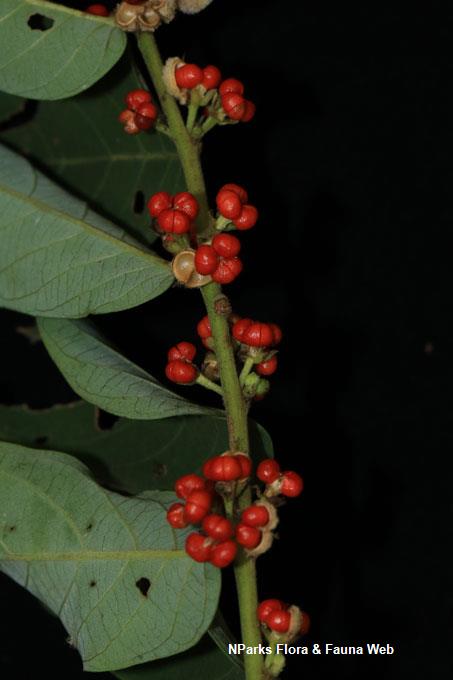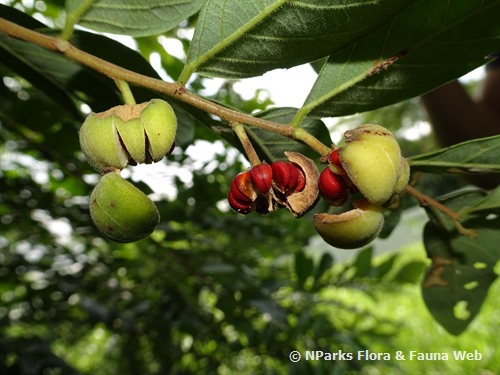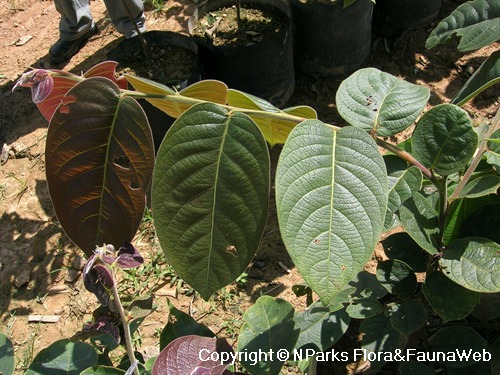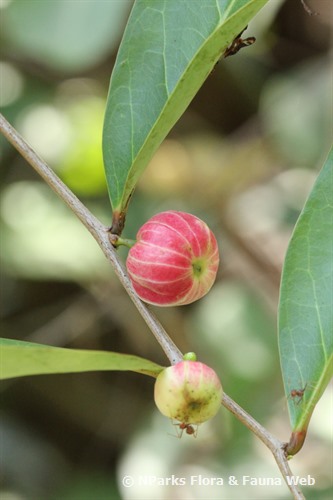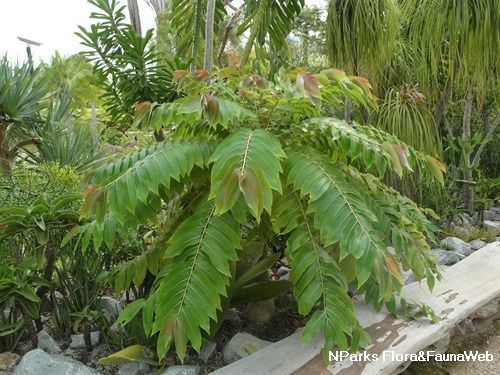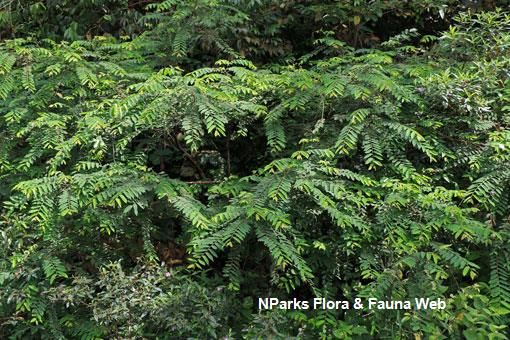
Back
Glochidion sericeum (Blume) Zoll. & Moritzi
| Family Name: | Phyllanthaceae |
| Synonyms: | Diasperus sericeus (Blume) Kuntze |
| Common Name: | Kenidei Bukit, Sindarong |
Glochidion sericeum or Kenidei Bukit is a shrub to small tree native to Singapore. Growing to a height of 8 m tall, it produce leaves that have a faint asymmetrical leaf base, greyish underside. Flowers are whitish, monoecious, borne on an inflorescence found along the axils. The fruit is a round, flattened green capsule covered in white, velvety hairs that splits from the base to reveal bright red, half-moon shaped seeds within.
Name
Classifications and Characteristics
| Plant Division | Angiosperms (Flowering Seed Plants) (Dicotyledon) |
|---|---|
| Plant Growth Form | Tree (Small (6m-15m)) |
| Maximum Height | 8 m |
Biogeography
| Native Distribution | Sumatra, West Java, Borneo, Philippines, Peninsular Malaysia, Singapore |
|---|---|
| Native Habitat | Terrestrial (Primary Rainforest, Secondary Rainforest) |
| Preferred Climate Zone | Tropical |
| Local Conservation Status | Native to Singapore (Critically Endangered (CR)) |
Description and Ethnobotany
| Growth Form | It is a shrub to small tree that can reach up to 8 m in height. Young vegetative parts are covered in fine, appressed, silky hairs. |
|---|---|
| Foliage | The leaves are ovately-elliptic (egg-shaped), papery, measuring 1.2 - 9 cm long by 0.8 - 3.4 cm wide. Both surface of the leaves are covered in fine, appressed, silky hairs while the top surface tend to be less conspicuous. Leaves have a greyish underside with veins flat above, prominent below, leaf bases are somewhat asymmetrical, faintly notched to box-shaped. |
| Flowers | Flowers are monoecious, borne on an inflorescence along the axils, holding both male and female flowers within the same cluster. Flowers are whitish, male flowers tend to be smaller than the female flowers. Male flowers measures at 1.2 - 5 mm wide while the female flowers measures 3.3 - 3.5 mm wide. |
| Fruit | The fruit is a round, flattened, green capsule covered in white velvety hairs, measuiring 6.2 - 7 mm long, 3.3 - 3.5 mm wide. Upon maturity, it spilts from the base of the fruit to reveal bright red, half-moon shaped seeds within. |
| Habitat | Occurs in evergreen forest, common along edges of woods and thickets, on granitic rocks, 50 - 200 m altitude. |
| Similar | G. sericeum and G. obscurum are similar in appearance. They can differentiated by the leaf base, number of veins and fruit morphology. G. sericeum has a mildly asymmetrical leaf base, bear 7 - 11 pairs of lateral veins and produce smaller fruit that are <5 mm wide, borne close to the axils while G. obscurum has a distinctive asymmetrical leaf base, bear 4 - 8 lateral veins on the smaller side of the blade and produce larger fruit that are >10 mm wide, borne on a longer stalk. |
| Cultivation | It can be propagated by seeds |
| Etymology | The genus, Glochidion refers to Glochid which meant 'Spine' in references to the staminal column of the male flowers. The species epipthet, sericeum, in latin, sericeus refers to the indumentum found on various parts of the plant. <1 ,2> |
Fauna, Pollination and Dispersal
| Fauna Pollination Dispersal Associated Fauna | Moth Food Plant |
|---|---|
| Pollination Method(s) | Biotic (Fauna) (, Insects (Butterfly, Moth)) |
Plant Care and Propagation
| Light Preference | Full Sun |
|---|---|
| Water Preference | Moderate Water |
| Plant Growth Rate | Moderate |
| Rootzone Tolerance | Fertile Loamy Soils, Well-Drained Soils |
| Propagation Method | Seed |
Foliar
| Foliage Retention | Evergreen |
|---|---|
| Mature Foliage Colour(s) | Green, Silver / Grey |
| Foliar Type | Simple / Unifoliate |
| Foliar Arrangement Along Stem | Alternate |
| Foliar Attachment to Stem | Petiolate |
| Foliar Shape(s) | Non-Palm Foliage (Elliptical, Ovate) |
| Foliar Venation | Reticulate |
| Foliar Margin | Entire |
| Foliar Apex - Tip | Acuminate, Acute |
| Foliar Base | Oblique / Asymmetrical, Truncate / Square |
Non - Foliar and Storage
| Stem Type & Modification | Woody |
|---|
Floral (Angiosperm)
| Flower & Plant Sexuality | Unisexual Flowers , Monoecious |
| Flower Colour(s) | White |
|---|
| Flower Grouping | Cluster / Inflorescence |
| Flower Location | Axillary |
| Flower Symmetry | Radial |
| Flowering Habit | Polycarpic |
Fruit, Seed and Spore
| Mature Fruit Colour(s) | Green, Red |
|---|---|
| Mature Fruit Texture(s) | Velvety / Furry / Tomentose |
| Fruit Classification | Simple Fruit |
| Fruit Type | |
| Mature Seed Colour(s) | Red |
References
| References | <1> Lam, W.N. et. al. (2022). Towards a field guide to the trees of the Nee Soon Swamp Forest (VII): Phyllanthaceae. Nature in Singapore suppl. 1: 117 - 118. <2> Van Welzen, P.C. & Chayamarit, K. (2007). Euphorbiaceae. Flora of Thailand. vol. 8(2), pp. 328 - 329. Bangkok: The Forest Herbarium, Department of National Park, Wildlife and Plant Conservation. |
|---|
Image Repository
Others
| Master ID | 34419 |
|---|---|
| Species ID | 8832 |
| Flora Disclaimer | The information in this website has been compiled from reliable sources, such as reference works on medicinal plants. It is not a substitute for medical advice or treatment and NParks does not purport to provide any medical advice. Readers should always consult his/her physician before using or consuming a plant for medicinal purposes. |

